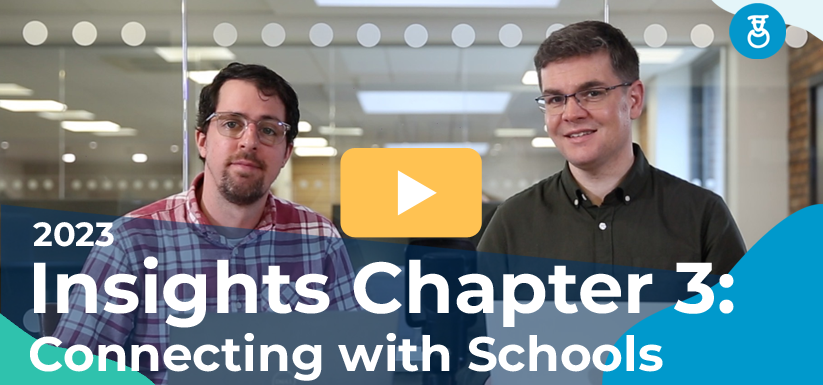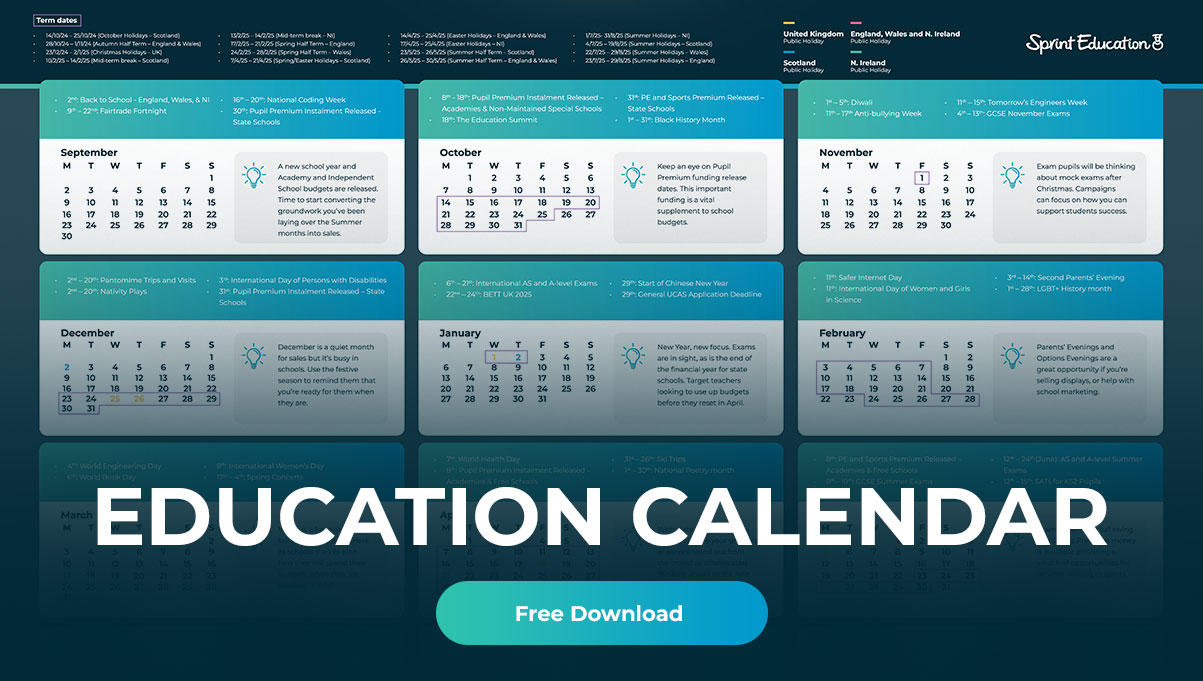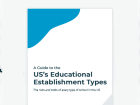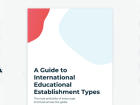A Guide to International Educational Establishment Types
A Guide to International Educational Establishment Types
Learn exactly who you're selling to with your international schools marketing with our breakdown of every educational establishment across the globe.
Learn exactly who you're selling to with your international schools marketing with our breakdown of every educational establishment across the globe.
Nursery
Including: Nursery Through Kindergarten, Through Preparatory, Through Middle, Through Secondary, Through High, Through Sixth Form, and Through College
Nursery school is an educational establishment that provides children with early childhood education before they enrol in compulsory education. Nursery schools may be publicly or privately operated, and may be subsidised from public funding.
Nursery is used as a form of childcare for working parents in many countries, but can also provide a form of education that’s largely the same across the globe: to prepare children for life in their country and school by supporting their childhood development and essential skills.
However, nurseries can still differ considerably across the globe. For instance, in India, nursery and preschool education is not o cially recognised by the government, so most nurseries are privately owned, but the demand is growing due to the rise in families where both parents are working. However, steps are being taken to formerly recognise preschool education, which would then cause a need to develop set curriculums and progress targets.
In comparison, Scottish nurseries have a strong emphasis on providing age-appropriate education rather than simply childcare. Their pre-school education is planned around the Curriculum of Excellence, which identifies outcomes and experiences across eight areas: Expressive Arts, Health & Wellbeing, Languages, Mathematics, Religious and Moral Education, Sciences, Social Sciences, and Technologies.
The age range of children who can attend nursery will differ between countries, as will what goes on in a nursery school. For instance, in the UK and US, children can attend nursery from the ages of zero to. Nurseries in these countries usually also operate pre-schools, which is held within the nursery but focuses more on personal development for children aged two to five.
Early Years Foundation
Including: EY Through High, Through Middle, Through Secondary, Through Senior, Through Sixth Form, and Through Upper
Early years schools are establishments that provide education that meets the Early Years Foundation Stage (EYFS) statutory framework in the UK. This framework outlines the standards that schools and childcare providers must meet for the learning, development, and care of children from birth to five. In most cases, this will be applicable to nurseries, preschools, and schools with EYFS years.
Some establishments will refer to themselves as an ‘Early Years Centre’, which can sometimes be in reference to their all-through nursery and pre-school stages, but sometimes is simply used as another word for nursery or pre-school.
Pre-School
(Includes Pre-School Through Elementary, Through Lower, Through Junior, Through Middle, Through Junior High, Through High, Through Secondary, Through Senior, Through Sixth Form, and Through Upper)
The terms ‘Nursery’ and ‘Pre-School’ are often used interchangeably. However, in most countries, there are a few key differences between the two. Pre-schools tend to follow a planned curriculum, as per the ‘school’ part of their name, and run more closely to standard school hours (8am-2pm for example, with closures over half terms and holidays) as opposed to nursery schools that may provide childcare for up to 12 hours a day.
Pre-schools usually require a percentage of their staff to be certified in early childhood education, as they provide more of a formal education. For this reason, pre-schools rarely accept children under the age of three, and only educate children up until they start school – at aged four or five, in most countries. While parents will use pre-school as a form of childcare, primarily its purpose is to provide children with a structured environment to facilitate a softer transition between home (or the more-relaxed nursery) and school.
The set curriculum and trained teachers usually make private pre-schools more expensive per hour than nurseries, although some countries will run free public nurseries.
Kindergarten
(Includes Through Primary, Through Middle, Through Secondary, Through High, Through Senior, Through Sixth Form, and Through University)
A form of preschool education, Kindergarten provides an approach based on playing, singing, hands-on activities, and social interaction to facilitate a softer transition from home to school. The term ‘kindergarten’ is used across the globe for a variety of educational establishments and learning spaces to serve children from the ages of two to six. However, there is a clear difference between kindergarten and nursery schools; kindergarten is more of a formal educational setting that provides a structured one-year education before starting school, as opposed to childcare and a focus on personal development.
In Germany, where kindergartens were established, they’re voluntary and usually privately owned (although subsidised by community councils), and tend to follow certain educational approaches, such as Montessori education. Although not a nursery, some will open for longer hours to facilitate childcare for children as young as three, and primary-aged pupils after their usual school hours.
In comparison, in the United States, kindergarten is a compulsory part of education in 43 of the 50 states that children attend from the age of five to six. Children here will develop skills such as numeracy, literacy, and social and cultural awareness.
Primary
(Includes Primary with Early Years; and Primary Through Middle, Through Senior, Through High, Through Secondary, Through Senior, and Through Sixth Form)
Primary school is an establishment that provides primary education to pupils usually aged four-11 (but sometimes up until the age of 13), sitting between preschool and secondary school. Primary school is the term used in the United Kingdom, Ireland, New Zealand, and South Africa; and interchangeably with the term ‘junior school’ in Australia. In North America and the Philippines, it’s known as grade school, and elsewhere across the globe, including the US, it’s known as elementary school.
The International Standard Classification of Education considers primary education as a single phase where programmes are typically designed to provide fundamental skills in reading, writing, and mathematics, and to establish a solid foundation for learning.
In most parts of the world, primary school is the first stage of compulsory education and is usually available without charge, but may also be offered by fee-paying independent schools. In some parts of the United States, ‘primary school’ can refer to a school covering kindergarten through to second or third grade, with their elementary schools then continuing the education from third through fifth, or fourth to sixth grade.
Elementary
(Includes Elementary Through High, Through Middle, Through Secondary, and Through Upper)
In many cases, ‘elementary school’ is used as a synonym for primary school. However, there are some subtle differences in a few locations, specifically regarding the age range of the intake. In Japan, elementary schools are roughly the same as primary schools, although accept pupils from the ages of six to 12, after which they enter junior high school.
In the US, most elementary schools cater to the same six to 12 age group, although the upper age limit can be anywhere between 10 and 14, depending on the state.
Secondary
(Includes Secondary Through Sixth Form, and Through College)
A Secondary school is an establishment that provides secondary education, following on from primary schools and preceding vocational or tertiary education. Attendance is usually compulsory for students up until the age of 16.
Some secondary schools provide both lower and upper secondary education (ages 12-15, and 15-18 respectively – levels 2 and 3 on the International Standard Classification of Education). These can also be provided in separate schools – such as standard secondary school for ages 11-16, and a separate sixth form for ages 16-18.
In other countries, secondary school is known as a high school or senior high school. In the cases where the International Standard Classification of Education levels 2 and 3 are split between schools, countries will have junior high schools, intermediate schools, lower secondary schools, and middle schools between their primary and high schools.
High School
(Includes High School Through Sixth Form, and Through University)
In most areas of the world, ‘high school’ is simply a term used interchangeably with ‘secondary school’. However, in the United States, high school is the term used for the education students receive in their final stage of secondary education – usually from the ages of 14 to 18. As opposed to secondary schools, which can deliver both levels 2 and 3 of the International Standard Classification of Education, American high schools generally deliver only level 3. Students attend high school after completing junior high school.
Infants
(Includes Infants Through Junior, and Through College)
Infant school is a term primarily used in England and Wales for settings providing primary education to pupils between the ages of four and seven. Infant schools are usually small settings serving a particular area, that provide Key Stage 1 education to pupils before they move up to a linked junior school.
Historically, infant and junior schools were separate establishments, but throughout the 1970s and 1990s, many merged into single primary schools. Since 2000, some of these schools have reverted back into separate infant and junior schools. These schools will provide exactly the same education as found in standard state or academy primary schools, but have the benefit of having fewer pupils and tailoring the entire school towards the younger pupils, which can be beneficial for some children.
Junior
(Includes Junior Through Middle, Through Senior, and Through Sixth Form)
After moving on from infant school, pupils in England and Wales will usually progress onto their linked junior school, which educates pupils from the ages of eight to 11. After junior school, most pupils then move onto a secondary school. As with infant schools, pupils at state junior schools will be taught the standard national curriculum, the same as state primary schools.
In Australia, junior schools are usually part of private schools, and educate children between the ages of two and five. In most primary schools, the junior primary is usually located within the same building or grounds as the primary school, although some are located on an adjacent or entirely separate site.
In Canada, mostly in Toronto, the term ‘junior school’ is used to refer to public schools from Kindergarten to Grade 5, but some boards of education will include Grade 6 in this description, too.
Senior
(Includes Senior Through Sixth Form)
The term ‘senior school’ has a few different uses, depending on the country. In England and Wales, senior school is another word for secondary school – post-primary education provided to students from the age of 11 to 16. In Scotland, senior school is another word for fifth year, or S5, a mandatory part of the leaving certificate and the last year before finishing school to head to Higher Education or work. Most students are usually 17 or 18 during senior school. This is the most difficult year of Scottish education due to the increase in difficulty of the courses being taken, as well as the amount of work required to complete them.
Over in Ontario, Canada, high school students in their third year and above are considered to be seniors, whereas in Alberta, Canada, only students in grade 12 are counted as seniors. In the United States, a senior student is one in their fourth year of study at high school (grade 12) or at university.
In every country, there will be schools using the term to refer to different stages of education. For instance, The Mengo Senior School in Kampala is a public middle school and high school that takes pupils from the age of 8 to 13. In the large majority of other countries, however, senior school tends be another word for secondary or high school.
Lower
Including: Lower Through High, and Through Sixth Form
In the UK, lower schools are found in a small percentage of local education authorities as part of the three-tier education approach of lower, middle, and upper school. Lower school, or first school, is the first step in pupils’ compulsory education, catering for pupils from the age of four or five until eight or nine.
This three-tier approach is becoming increasingly more outdated, with the large majority of UK schools following the two-tier primary and secondary approach. This is largely due to the introduction of the National Curriculum in 1988, which is divided into Key Stage groups that don’t fully align with the three-tier system. Lower schools cover all of Key Stage 1, but only part of Key Stage 2, and if a student transitioned to a two-tier secondary instead of middle school, they may be behind on the usual curriculum.
Middle
(Includes Middle Through Secondary, Through High, Through Senior, and Through Upper)
In the UK, middle schools are part of the three-tier education system, usually educating pupils between the ages of nine to 13 (although, depending on the region, this may be as young as seven). However, unlike lower and upper schools, middle schools are commonly found worldwide, educating preteen and younger teenage students.
For example, in the United States, middle schools (or ‘junior high schools’) are schools that educate pupils from as early as grade 5 to as late as grade 8, although some will cover shorter periods – the most common being grades 6 to 8. This range is often based on demographic factors, such as the change in relative numbers of younger or older students, in order to maintain stable school populations. In middle school, pupils usually start to choose their class subjects (known as ‘electives’), and their grades start to become officially recognised. The purpose of middle school is to bridge the gap between elementary and high school.
In other countries, middle school covers a slightly different age range. For instance, in Bosnia, middle school provides three to four years of post-elementary education for students aged 14 to 18. In China, their secondary education is known as middle school, covering grades 7-12.
Upper
In the UK, upper schools are a type of secondary school included in the three-tier education approach. Upper schools teach pupils from the age of 13 or 14 to 16 (or 18, if the school operates a sixth form). In some areas, upper schools may also be known as high schools.
In Buckinghamshire, the term ‘Upper School’ can refer to secondary schools which admit students without reference to the 11-plus exam, although these are also called secondary modern schools. In the United States, many independent and some parochial schools will also use the term ‘Upper School’ instead of high school to refer to grades 9-12.
Pre-Prep
(Includes Pre-Prep Through Preparatory, Through Upper, Through Senior, and Through Sixth Form)
Pre-Prep schools, found in the UK, teach children until they begin prep school. They’re usually associated with their prep schools, and so will follow the same curriculum, learning programmes, and development targets – just tailored to the younger pupils.
Pupils usually start at the age of five, but some pre-prep schools will have an associated nursery or kindergarten to accept children from the age of three.
Preparatory
(Includes Preparatory Through Secondary, Through College, and Through Sixth Form)
The term ‘Preparatory School’ can refer to two different establishments depending on the country. In the UK, preparatory school (or ‘prep’ school) is a fee-paying independent primary school that educates pupils up until the age of 11 or 13. The aim of the school is to prepare students for their Common Entrance Exam to secure a place at an independent secondary school (usually one of the English public schools) or a state selective grammar school.
Preparatory schools can be co-educational, but separate boys’ and girls’ prep schools aren’t uncommon. Boys’ prep schools usually take on pupils from the age of eight to 13, whereas girls’ prep schools usually take on pupils earlier, from the age of four, and educate them until they’re 11. Prep schools may be day schools or boarding schools (or a combination). They may be fully independent, joined with a secondary, choir schools, religious schools, or SEN schools, but most are inspected by the Independent Schools Inspectorate.
In the United States, however, preparatory school is a type of secondary education designed to prepare students aged 13-18 for higher education (also known as college-preparatory school or prep school).
These schools are usually private schools connected to a local school district, although some may be public or charter schools. Some will offer specialised courses and a curriculum that prepares students for specific fields of study, but some simply use the ‘preparatory school’ title to attract new students without actually differing from a typical high school. However, most are usually elite private schools with selective admission criteria and high tuition fees. Loans are available, but other financial aid usually is not; tuition can cost anywhere from $10,000-$40,000 per year. Like UK prep schools, the US establishments can be day schools, boarding schools, or a mix; and may be co-educational or single-sex.
In Japan, college prep-schools are considered prestigious and difficult to get into, although there are different tiers of prep schools with different entry requirements depending on which university the school leads into. The Japanese government provides grants for prep school, meaning tuition usually falls in the realm of $5,000-$10,000 US dollars per year.
Sixth Form College
Sixth Form College represents the two years of education undertaken between the ages of 16 and 18 as standard (although it’s not uncommon for some students to retake a year and finish at the age of 19). Sixth Form refers solely to post-16 academic education, and not to vocational education.
In England and Wales, students attend Sixth Form after finishing their GCSEs. The first year of Sixth Form is also known as Lower Sixth, or Year 12, and the second year Upper Sixth, or Year 13. Students will study between three to five AS Levels in their first year, and in the second will continue studying to turn these into full A Levels. They may also drop subjects after the first year, but will retain their AS Level certification for these. Collectively, both years can also be referred to as Key Stage 5. Sixth Form is not compulsory, but most universities require A Levels to apply; AS and A Level results are converted into UCAS points, and universities will ask for a specific number of points in their offer of study.
In Scotland, Sixth Form is known as Sixth Year or S6. Students study Advanced Higher and/or Higher courses and take SQA exams at the end of S5 and S6. Sixth Year is not essential for students wishing to attend a Scottish university if their S5 results are adequate, but many students complete Sixth Year regardless. In some Independent Schools in Scotland, Sixth Form can also refer to the final two years of secondary education.
In some Secondary Schools in Jamaica, Barbados, and Trinidad and Tobago, the sixth and seventh years are called Lower and Upper Sixth respectively. In India and Nepal, Sixth Form is the ‘+2’ in the ‘10+2’ education system. In Malta, Sixth Form is again used to define the final two years of education prior to entering university.
In Malaysia, Sixth Form is known as ‘Tingkatan 6’, and lasts for three semesters. In Singapore, their equivalent of Sixth Form is ‘Junior College’, where pupils take their Cambridge GCE A Levels after two years.
In New Zealand, under their old education system, Sixth Form was the equivalent to today’s Year 12, and Year 13 was known as Seventh Form. The Australian system sometimes uses the term for their Year 12 groups.
In Brunei, Sixth Form is similar to England and Wales. The two years are known as Year 12 and 13, or Lower and Upper Sixth, and students will sit their Brunei-Cambridge GCE A Levels after both years. Students also have the option to take AS Levels at the end of the first year, or halfway through the second. Sixth Form is also not compulsory, but a common choice for students wishing to head to university.
In some college preparatory schools in the United States, Sixth Form refers to the final year of education prior to college – the equivalent of twelfth grade in their education system.
College
Across the globe, ‘college’ can refer to several different establishments: a high school or secondary school, further education college, higher education provider without university status, training institution that awards trade qualifications, or a constituent part of a university.
The Latin meaning of the word translates to mean ‘selected together’, which explains the wide range of establishments – it’s essentially a word to describe students who have selected, or been selected, to work together.
In Canada, as an example, colleges usually refer to trade schools, community colleges, or specific industry schools (such as business or technology school). These are post-secondary institutions granting certificates, diplomas, associate degrees, and (in some cases) bachelor’s degrees. There is a strong distinction between ‘college’ and ‘university’.
In contrast, ‘college’ in the United States is a colloquial term for any post-secondary undergraduate education, although formerly refers to a constituent part of a university. Usage of the term varies among the states, with some following Canada’s example and calling all four-year colleges universities, and renaming vocational technology schools to technical colleges.
In other areas of the world, ‘college’ tends to represent secondary or high schools. This is the case in Zimbabwe, where college is mainly used by private or independent secondary schools offering A Levels, or Polytechnic Colleges.
A few private secondary schools in the UK do the same, although the term largely refers to further education colleges and sixth forms that provide education to students over the age of 16.
University
Across the globe, Universities are institutes of higher (or tertiary) education and research, offering undergraduate and postgraduate programmes to award students with academic degrees in a variety of disciplines.
There are over 25,000 universities across the globe, each with their own ways of working and degree standards; some universities have tighter admission regulations and education standards, making a first-class degree more impressive.
In many countries, students are required to pay full tuition fees, and students look to get student grants or loans to cover the cost. In the US, tuition fees cost an average of $30,000 per student. Scholarships may also be awarded to students based on talent or special circumstances, which can reduce or completely eliminate tuition fees.
In many European countries, it’s possible to attend university with no tuition fees. Nordic public universities were free to attend until 2005. Denmark, Sweden, and Finland then put in place fees for foreign students. Citizens of the EU, the EEA, and Switzerland can still attend for free. Public universities in Germany charge only a small administrative fee, although private universities almost always charge tuition fees.
Distance Learning
Distance Learning, or Distance Education, is the method of teaching students who may not always be physically present in school. Distance Learning became fully established in the 1800s, with students learning through weekly lessons sent via the post. Technology then progressed to enable learning via radio and then television, but distance learning now usually takes the form of online education. Distance learning programmes may be a hybrid of online and classroom education, or may take place solely online.
The sheer power of the internet means schools have the option to continue their standard schooling online, using software such as Zoom and Microsoft Teams to teach the same curriculum as they would in the classroom with only minor alterations. However, the scale of resources available means schools can also turn to preprepared resources, platforms, and full mapped-out curriculum programmes as an alternative. These can be tailored to suit the country’s education scheme, and even the school’s specific curriculum, to support the usual learning scheme.
The COVID-19 pandemic forced schools worldwide to close, and deliver online remote learning. While there were several disadvantages and setbacks, largely due to the zero-notice closures, it has opened the doors to new opportunities to support students. For instance, many schools across the globe are now trialling distance learning to educate students who are out of school due to long-term illness or have been excluded from mainstream school.
Finishing School
Established in the late 19th century, Finishing Schools focused on preparing wealthy young women to enter society and acquire husbands through teaching social graces and upper-class rites. They are also known as Charm Schools across some countries, including the US.
The 1960s marked the decline of the traditional Finishing School, although the 1990s saw their revival, with a radically altered business model.
Now, Finishing Schools still provide women usually aged 16-25 with education designed to follow from regular school and complete their education. However, Finishing Schools now have a larger focus on culture and career skills, such as languages, literary studies, and business skills. The programmes may be completed over several weeks as an intensive course, or a one-year programme.
Finishing Schools were most popular across Switzerland, known for their healthy environments, multi-lingual and cosmopolitan aura, and the region’s political stability. Schools were also found across the UK and US. However, many of the once-popular establishments have now either closed or shifted to become closer to a modern-day college. Only one of Switzerland’s traditional Finishing Schools that don’t teach academic subjects remains, which now offers courses of one to six weeks on a variety of cultural subjects.
Group
Groups are districts of accredited international schools that provide usually British and American education to expatriate families and national students. One example is the International Schools Group, a not-for-profit district that operates five individual schools across the Eastern Province of Saudi Arabia. These schools, categorised into American and British schools, offer the standard American curriculum and National Curriculum of England and Wales respectively. Other than the curriculum, schools in these groups will be accredited, licensed, and governed following the country’s usual education standards.
SEN
SEN schools cater for students with SEND (special educational needs and disability), be that due to learning difficulties, physical disabilities, or behavioural problems. Some of these students will receive special education through specialised programmes at mainstream schools, but those who need higher levels of support can attend SEN Schools instead (usually not entering mainstream classes at all). These students will usually not follow the country’s standard curriculum.
SEN schools provide individualised education to address specific needs, and lower student-to-teacher ratios (usually 6:1 or lower) to facilitate more one-to-one support. SEN schools will usually have other facilities for SEND students, such as sensory rooms or swimming pools.
SEN schools are declining in numbers, as countries work to provide more students with SEN programmes in mainstream schools. To facilitate this, some schools will have separate buildings known as a special unit or special classroom, which is a classroom dedicated solely to the education of SEND students within mainstream education. Some students may be educated full-time in the special unit, but still be considered a student of the overall mainstream school. Some may have timetabled sessions in the special unit, but have classes in the mainstream school, too.
SEN Schools and SEND education must be informed by their country’s government standards. For example, the Australian Association of Special Education Inc.’s position is informed by the Disability Standards for Education 2005, which ensure SEND students are treated on the same basis as other students in regards to enrolment and participation in education. Special education in Singapore is centrally regulated by the Singapore Ministry of Education. In Europe, each country has its own special education support structures, and 31 countries are covered by the European Agency for Special Needs and Inclusive Education.
What next?
There you go – a brief run-down of all 23 international school types you can market to in Campus. But there’s no time to waste – those 23 school types equate to hundreds of thousands of schools and teachers all waiting to hear from you!
When you’re ready to reach out to them, plus learn more about which schools your business must be emailing, get in touch on info@sprint-education.co.uk or 01684 297373 for a walkthrough of Campus.
Tags
Database of Schools
Education Data
Education Database
Email Schools
List of Schools
Schools Database
Similar Articles


VIDEO: Connecting with Schools - Selling to Schools Insights Chapter 3
Join us as we delve into chapter 3 of The State of Selling to Schools report 2023. Together we reveal what the findings show us about when to connect with teachers, why certain times are more popular and the ideal notice periods for different education business providers.


Introducing... The UK Teacher and School Insights Module
Access essential buying data from teachers and school staff to power up your marketing campaigns - directly from your education CRM!


Expert marketing to schools support and solutions
Expert marketing to schools solutions
Email Head Teachers, Teachers, and Staff Inboxes
Email teachers and staff inboxes
Sell More to UK and Global Schools and Colleges
Sell more to schools and colleges
































